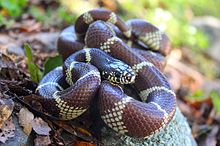California kingsnake
| California kingsnake | |
|---|---|
 |
|
| Scientific classification | |
| Kingdom: | Animalia |
| Phylum: | Chordata |
| Subphylum: | Vertebrata |
| Class: | Reptilia |
| Order: | Squamata |
| Suborder: | Serpentes |
| Family: | Colubridae |
| Genus: | Lampropeltis |
| Species: | L. getula |
| Subspecies: | L. g. californiae |
| Trinomial name | |
|
Lampropeltis getula californiae (Blainville, 1835) |
|
| Synonyms | |
|
|
The California kingsnake (Lampropeltis getula californiae) is a nonvenomous colubrid snake endemic to the western United States and northern Mexico. It is a relatively small subspecies of the common kingsnake and is found in a variety of habitats. Due to ease of care and a wide range of color variations, the California kingsnake is one of the most popular snakes in captivity.
The California kingsnake is widespread along the West Coast of North America to elevations of approximately 6,100 ft (1,900 m) in the Tehachapi Mountains and to over 7,000 ft (2,100 m) in the southeastern Sierra Nevada Mountains. This species lives in a wide variety of habitats, including woodland chaparral, grassland, deserts, marshes, and even suburban areas. These snakes live in Oregon, California, Nevada, Utah, Arizona, and Northwestern Mexico. In Arizona, they intergrade with the desert kingsnake and the Mexican black kingsnake. The species has also become invasive on the Spanish island of Gran Canaria.
The California kingsnake is primarily diurnal, but may become increasingly nocturnal during periods of particularly hot weather. In the winter, they retreat underground and enter a hibernation-like state called brumation. When disturbed, California kingsnakes will often coil their bodies to hide their heads, hiss, and rattle their tails, which can produce a sound somewhat resembling that of a rattlesnake. They are considered harmless to humans, but if handled it is common for this species to bite as well as excrete musk and fecal contents from their cloaca.
California kingsnakes are opportunistic feeders, and common food items include rodents, other reptiles, birds, and amphibians. All kingsnakes are non-venomous, but are powerful constrictors and generally kill their prey through suffocation. The "king" in their name refers to their propensity to hunt and consume other snakes, including venomous rattlesnakes that are commonly indigenous to their natural habitat. California kingsnakes are naturally resistant to the venom of rattlesnakes but are not totally immune.
...
Wikipedia
